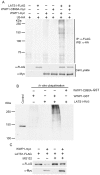WWP1 E3 ligase targets LATS1 for ubiquitin-mediated degradation in breast cancer cells
- PMID: 23573293
- PMCID: PMC3616014
- DOI: 10.1371/journal.pone.0061027
WWP1 E3 ligase targets LATS1 for ubiquitin-mediated degradation in breast cancer cells
Abstract
The Large Tumor Suppressor 1 (LATS1) is a serine/threonine kinase and tumor suppressor found down-regulated in various human cancers. LATS1 has recently been identified as a central player of the emerging Hippo signaling pathway, which plays important roles in organ size control, tumorigenesis, and stem cell differentiation and renewal, etc. Although mounting evidence supports a role of LATS1 in tumor suppression and tumorigenesis, how LATS1 is regulated at the molecular level is not fully understood. Recently several positive regulators of LATS1 (Mst1/2, MOB1, Kibra, etc) have been identified but how LATS1 is negatively regulated is still largely unknown. We have recently identified Itch, a member of the NEDD4-like family E3 ubiquitin ligases, as a novel negative regulator of LATS1. However, whether other ubiquitin ligases modulate LATS1 stability and function is unclear. By screening many E3 ligases of the NEDD4-like family using over-expression and short-interference RNA knockdown approaches, we have identified WWP1 E3 ligase as another novel negative regulator of LATS1. We have provided in vitro and in vivo evidence that WWP1 is essential for LATS1 stability and negatively regulate LATS1 by promoting LATS1 degradation through polyubiquitination and the 26S proteasome pathway. Importantly, we also showed that degradation of LATS1 is critical in mediating WWP1-induced increased cell proliferation in breast cancer cells. Since WWP1 is an oncogene and LATS1 is a tumor suppressor gene in breast cancer, our studies provide a promising therapeutic strategy in which developed drugs targeting WWP1 cause activation of LATS1 in suppressing breast cancer cell growth.
Conflict of interest statement
Figures






Similar articles
-
Itch E3 ubiquitin ligase regulates large tumor suppressor 1 stability [corrected].Proc Natl Acad Sci U S A. 2011 Mar 22;108(12):4870-5. doi: 10.1073/pnas.1101273108. Epub 2011 Mar 7. Proc Natl Acad Sci U S A. 2011. PMID: 21383157 Free PMC article.
-
The E3 ubiquitin ligase WWP1 selectively targets HER4 and its proteolytically derived signaling isoforms for degradation.Mol Cell Biol. 2009 Feb;29(3):892-906. doi: 10.1128/MCB.00595-08. Epub 2008 Dec 1. Mol Cell Biol. 2009. PMID: 19047365 Free PMC article.
-
NEDD4 E3 ligase inhibits the activity of the Hippo pathway by targeting LATS1 for degradation.Cell Cycle. 2013 Dec 15;12(24):3817-23. doi: 10.4161/cc.26672. Epub 2013 Oct 7. Cell Cycle. 2013. PMID: 24107629 Free PMC article.
-
WWP1 E3 ligase at the crossroads of health and disease.Cell Death Dis. 2023 Dec 21;14(12):853. doi: 10.1038/s41419-023-06380-0. Cell Death Dis. 2023. PMID: 38129384 Free PMC article. Review.
-
Regulation of the Hippo signaling pathway by ubiquitin modification.BMB Rep. 2018 Mar;51(3):143-150. doi: 10.5483/bmbrep.2018.51.3.017. BMB Rep. 2018. PMID: 29366444 Free PMC article. Review.
Cited by
-
Using Biosensors to Study Protein-Protein Interaction in the Hippo Pathway.Front Cell Dev Biol. 2021 Apr 26;9:660137. doi: 10.3389/fcell.2021.660137. eCollection 2021. Front Cell Dev Biol. 2021. PMID: 33981705 Free PMC article. Review.
-
WW Domain-Containing E3 Ubiquitin Protein Ligase 1: A Self-Disciplined Oncoprotein.Front Cell Dev Biol. 2021 Oct 12;9:757493. doi: 10.3389/fcell.2021.757493. eCollection 2021. Front Cell Dev Biol. 2021. PMID: 34712671 Free PMC article. Review.
-
The ubiquitin E3 ligase ITCH enhances breast tumor progression by inhibiting the Hippo tumor suppressor pathway.Oncotarget. 2014 Nov 15;5(21):10886-900. doi: 10.18632/oncotarget.2540. Oncotarget. 2014. PMID: 25350971 Free PMC article.
-
Deubiquitylase USP9X suppresses tumorigenesis by stabilizing large tumor suppressor kinase 2 (LATS2) in the Hippo pathway.J Biol Chem. 2018 Jan 26;293(4):1178-1191. doi: 10.1074/jbc.RA117.000392. Epub 2017 Nov 28. J Biol Chem. 2018. PMID: 29183995 Free PMC article.
-
GPRC5A promotes lung colonization of esophageal squamous cell carcinoma.Nat Commun. 2024 Nov 16;15(1):9950. doi: 10.1038/s41467-024-54251-9. Nat Commun. 2024. PMID: 39550386 Free PMC article.
References
-
- Visser S, Yang X (2010) LATS tumor suppressor: A new governor of cellular homeostasis. Cell Cycle 9: 3892–3903. - PubMed
-
- Yang X, Yu K, Hao Y, Li DM, Stewart R, et al. (2004) LATS1 tumour suppressor affects cytokinesis by inhibiting LIMK1. Nature Cell Biology 6: 609–617. - PubMed
-
- Yang X, Li DM, Chen W, Xu T (2001) Human homologue of drosophila lats, LATS1, negatively regulate growth by inducing G(2)/M arrest or apoptosis. Oncogene 20: 6516–23. - PubMed
-
- Lai D, Ho KC, Hao Y, Yang X (2011) Taxol resistance in breast cancer cells is mediated by the hippo pathway component TAZ and its downstream transcriptional targets Cyr61 and CTGF. Cancer Research 71: 2728–2738. - PubMed
-
- Tremblay AM, Camargo FD (2012) Hippo signaling in mammalian stem cells. Seminars in Cell & Developmental Biology 23: 818–826. - PubMed
Publication types
MeSH terms
Substances
Grants and funding
LinkOut - more resources
Full Text Sources
Other Literature Sources
Research Materials
Miscellaneous

